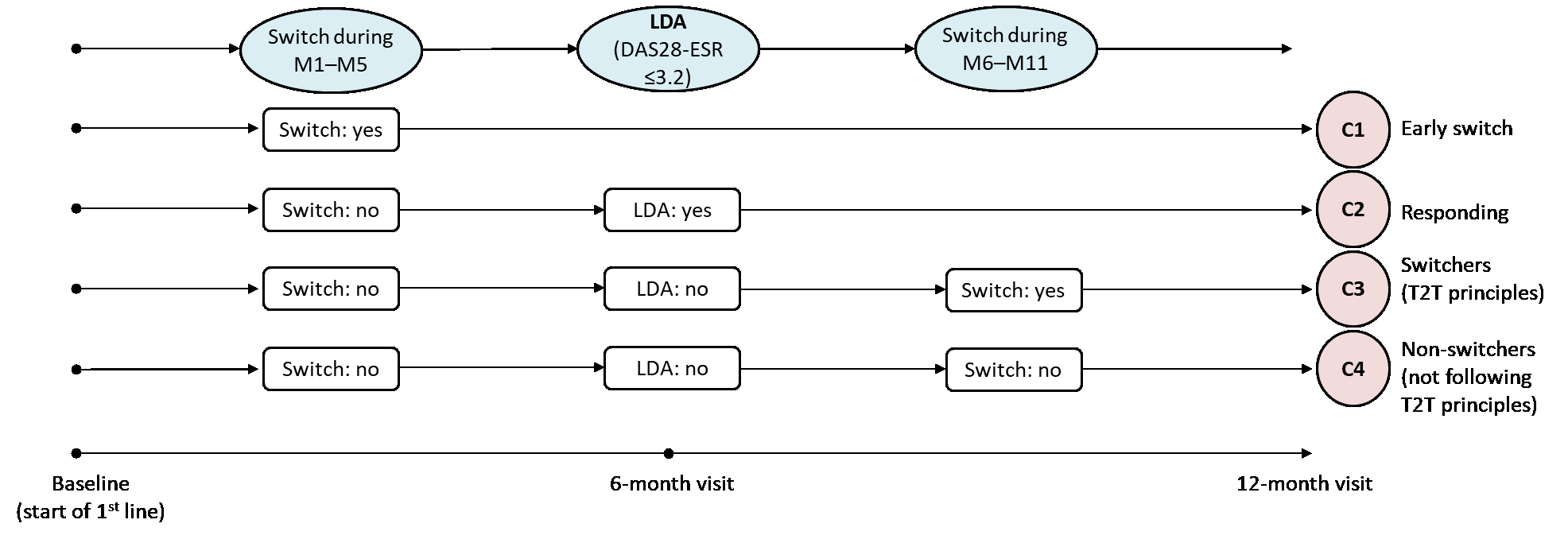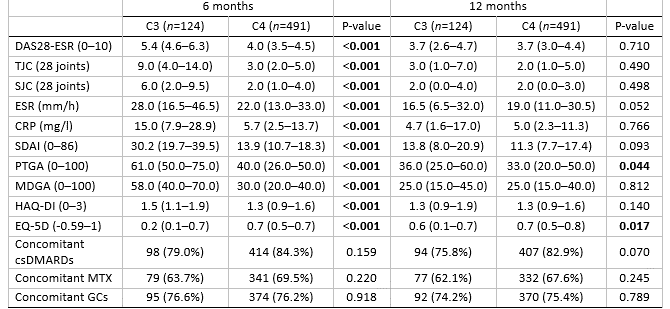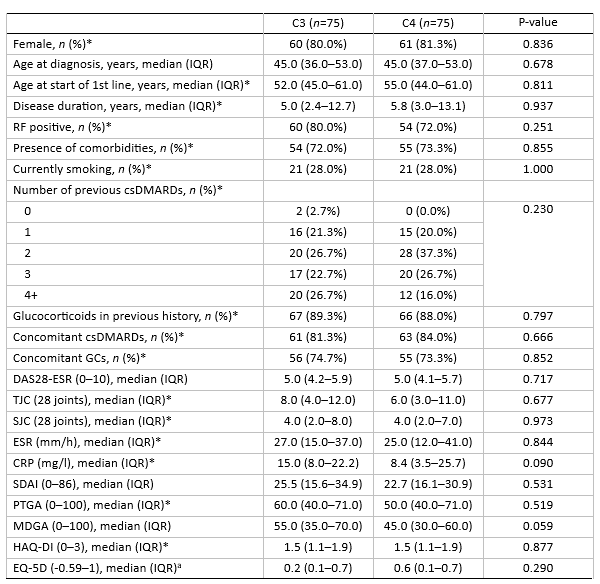Session Information
Date: Saturday, November 7, 2020
Title: RA – Treatments Poster II: Comparative Effectiveness, Biosimilars, Adherence & the Real World
Session Type: Poster Session B
Session Time: 9:00AM-11:00AM
Background/Purpose: Treat-to-target (T2T) is a widely accepted management strategy for RA. It recommends attaining a goal of at least low disease activity (LDA) within 6 months, otherwise the current therapy should be modified. We assessed the compliance with and effectiveness of the T2T principles in real clinical practice using data in the Czech biologics register ATTRA. The ATTRA registry captures more than 95% of patients with RA treated with bDMARDs/tsDMARDs (or Targeted Therapies, TTs) in the Czech Republic (CZ). In CZ, TTs is reimbursed for RA if DAS28 >5.1 despite therapy with csDMARDs. We aimed to investigate whether switching the first-line targeted drug in pts not reaching LDA within the 6 months since baseline leads to a higher probability of meeting LDA at 12‑month visit.
Methods: We included all adult RA patients starting first-line TT from 1 January 2012 to 31 January 2017 with at least one-year follow-up (FUP), and available DAS28-ESR at baseline, 6- and 12-month visits. We created four mutually exclusive cohorts C1-4 based on 1) switching (and its timing) to another TT within the first year, and 2) reaching LDA (DAS28-ESR ≤ 3.2) at 6‑month visit (Fig 1). The primary outcome was the comparison of odds for reaching LDA at the 12-month visit between patients switching and not switching TT after not reaching LDA at 6 months. Before using logistic regression to estimate the odds ratio, we employed the propensity score (PS) to match patients and make them comparable in characteristics related to disease activity and quality of life at the 6-month visit.
Results: 1275 patients were eligible for the analysis. 62 patients switched within the first 1-5 months of the treatment before evaluating treatment response at the 6-month visit (C1). 598 patients reached LDA within six months of therapy (C2), 124 patients did not reach LDA at 6-month visit and switched to another therapy (C3), and 491 patients continued with the same treatment despite not reaching LDA at the 6-month visit (C4). Clinical cahracteristics of cohorts C3 and C4 at 6 and 12 months are shown in table 1.75 patients from cohort C3 and 75 patients belonging to a cohort C4 were matched using the PS (table 2). After PS matching, patients following T2T principle (C3) showed 2.8 (95% CI 1.4–5.8; p=0.005) times increased likelihood of achieving LDA at 12‑month visit compared to patients not following T2T strategy (C4).
Conclusion: In daily clinical practice, application of T2T strategy is underused. Switching to another TT after not reaching LDA within the first six months leads to a higher probability of achieving LDA in RA patients at the 12-month visit.
Acknowledgements: Supported by project 00023728 of Ministry of Health, CZ.
 Figure 1. Definition of studied cohorts (C1–C4)
Figure 1. Definition of studied cohorts (C1–C4)
 Table 1 Comparison of parameters related to disease activity, quality of life and concomitant therapy between C3 and C4 cohort at the 6-month and 12-month visit (before PS matching)
Table 1 Comparison of parameters related to disease activity, quality of life and concomitant therapy between C3 and C4 cohort at the 6-month and 12-month visit (before PS matching)
 Table 2. Description of patients from C3 and C4 cohort at 6-month visit after applying propensity score matching
Table 2. Description of patients from C3 and C4 cohort at 6-month visit after applying propensity score matching
To cite this abstract in AMA style:
Závada J, Nekvindova L. Treat-to-target Strategy in Patients with Rheumatoid Arthritis in Daily Clinical Practice -still Underused, but Superior to Routine Care: A Propensity Score Matched Analysis from the ATTRA Registry [abstract]. Arthritis Rheumatol. 2020; 72 (suppl 10). https://acrabstracts.org/abstract/treat-to-target-strategy-in-patients-with-rheumatoid-arthritis-in-daily-clinical-practice-still-underused-but-superior-to-routine-care-a-propensity-score-matched-analysis-from-the-attra-registry/. Accessed .« Back to ACR Convergence 2020
ACR Meeting Abstracts - https://acrabstracts.org/abstract/treat-to-target-strategy-in-patients-with-rheumatoid-arthritis-in-daily-clinical-practice-still-underused-but-superior-to-routine-care-a-propensity-score-matched-analysis-from-the-attra-registry/
